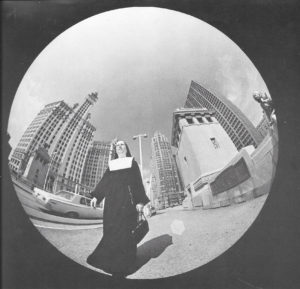Salvatorian Sisters respond to Second Vatican Council

When Pope John XXIII convoked the Second Vatican Council (1962-1965), the Sisters of the Divine Savior eagerly responded to its challenge to “renew the church in the modern world.” In her book, Bending in Season, Sister Margaret Shekleton, SDS, wrote, “[We] embraced the principles of the movement….” While excitement and change filled the air, it also brought countless new challenges and opportunities in its wake.

For one, our sisters moved away from some long held traditions to embrace new approaches that spoke more clearly to the times. They asked to pray their daily office in English (rather than Latin) and received that permission in 1965. Prior to Vatican II, their daily routines were typically more rigidly monastic. Soon after, they could take part in activities such as picnics with their families, vacations and even swimming.
Above all else, our sisters were committed to Vatican II’s call to revitalize the mission of all baptized persons. Until this time, the sisters typically lived with larger groups of sisters in convents. Now they began to transition to apartments and smaller houses, rooting themselves in the local communities they served. They also expanded their apostolates. Along with teaching and nursing, sisters now served as social workers, retreat directors, artists and psychologists. Some took on administrative tasks, working as secretaries, accountants and business managers, even in entities not owned by the congregation.

Taking these changes in stride, our sisters also adapted to challenges along the way. Before the 1960s, provincial leaders assigned sisters to schools and hospitals, where they typically learned by experience on the job. Now, more highly educated thanks to the Sister Formation Movement, sisters served alongside equally competent lay persons. They were also held to the same professional standards. For the first time, our sisters interviewed and signed contracts for jobs just like their lay counterparts.
Immersed in a more secular environment, many of our sisters abandoned any special privileges the habit once granted them. Many opted to modify and eventually abandon wearing the habit. Up to this point, the religious habit had to meet specific fabric and design guidelines. It was seen as a symbol of consecration to God and separateness from the world. Now convenience, comfort and the desire to work “with” rather than “over” their co-workers became higher priorities, especially in newer apostolates. Modifying the habit and eventually adopting simple secular dress were done with thoughtful deliberation, prompted by the sisters’ deep desire to be more fully immersed in mission in the modern world.
Mother Aquin Gilles, SDS, then North American Provincial Leader, used each of these changes as an opportunity to unify our sisterhood. At the time, only sisters who had taken the perpetual vows could vote at the Provincial Chapter. Nevertheless, Mother Aquin valued the input of younger sisters. She channeled the openness of Vatican II, inviting all sisters to have a say in how the Salvatorians would adapt and grow.
In a 1964 letter to the congregation, she wrote, “It is the nature of a family, and a religious family is no exception, to be interested in the progress of the whole family.”
Our 125 Year Celebration
As we look back on our 125th anniversary of coming to the USA, we invite you to reminisce with us. We've launched all 5 time lines with historical milestones and stories that bring to life the experiences of our sisters who came before us.
Era 1: 1895-1920
Responding to Immigrant Needs
The missionary response of hearty immigrant women religious characterizes the first 25 years of Salvatorian Sisters’ presence in the United States ...
Era 2: 1920-1950
Expanding in an “American” Church
By 1920, life for a Salvatorian Sister in the USA was radically different than it had been 25 years earlier. World War I ....
Era 3: 1950-1970
Embracing Renewal
Bob Dylan’s 1964 classic, The Times They Are A Changing, captures the high energy of this era. Change was afoot both outside and inside the Salvatorian convent walls...
Era 4: 1970-2000
Building Collaboration
Events of the mid-1960s renewed the collaborative energy that had always characterized Salvatorian life. Cloistered living ...
Era 5: 2000-2020
Searching for New Footing in a Changing World
When the new millennium arrived on January 1, 2000, Salvatorian Sisters were already five years into our second century on USA soil. Our ...
